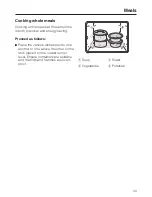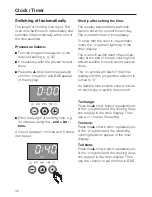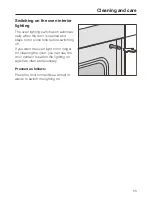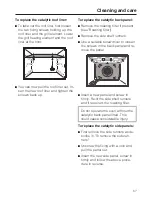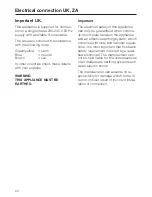
Cleaning catalytic enamel
surfaces
The roof and the back wall of the oven
and side panels (if fitted) which can be
difficult to reach for cleaning have spe-
cial liners which are coated with cata-
lytic enamel. Catalytic enamel has very
good self-cleaning propreties.
During fan operated cooking circulating
air in the oven deposits oil and fat
splashes predominantly on the back
panel of the oven.
The catalytic liners absorb oil and
splashes of fat. These splashes are
burnt off at temperatures over 200 °C.
The higher the temperature, the more
effective the process.
Before cleaning the catalytic panels
using high temperatures, make sure
that all P
ERFECT
C
LEAN
surfaces have
been cleaned as previously de-
scribed. Otherwise, the high temper-
atures can cause deposits to be-
come baked on to the P
ERFECT
C
LEAN
surfaces and become impossible to
remove.
Depending on the level of soiling, heat-
ing the oven to a high temperature, as
follows, will help remove soiling on the
catalytic surfaces which has been
caused by oil and grease splashes:
^
With the oven empty, select Fan heat
D
and the highest temperature pos-
sible. Run the oven for approximately
1 hour.
The length of time will depend on the
level of soiling.
It is a good idea to set the finish time for
the process using the timer (see
"Switching off automatically"). This way
you will not forget to switch the oven off
at the end.
However, deposits of spices, syrups
and similar substances are not re-
moved by the catalytic cleaning. These
are best removed while fresh by hand
with a mild solution of warm water and
washing up liquid applied with a soft
brush. Do not wait too long between
cleaning sessions as further baking and
roasting will cause the deposits to bake
on even harder with each subsequent
use of the oven.
Do not use abrasive cleaning
agents, hard brushes, scouring
pads or cloths, steel wool, knives or
other abrasive materials and do not
use oven spray on catalytic enamel.
These damage the surface render-
ing its self-cleaning properties inef-
fective.
After a period of time and depending
on the amount and type of use of the
oven, the matt surface of the catalytic
liners can change in appearance, e.g.
splashes of fat will be visible, and be-
come ineffective. Replacement liners
can be obtained from your dealer or the
Miele Spare Parts Dept and fitted as
described in the following section.
Cleaning and care
56


